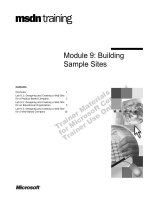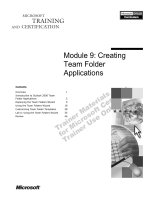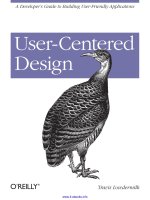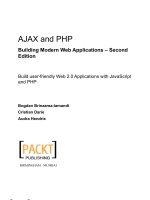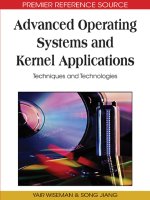Java 9 building robust modular applications master advanced java features and implement them to build amazing projects
Bạn đang xem bản rút gọn của tài liệu. Xem và tải ngay bản đầy đủ của tài liệu tại đây (24.66 MB, 1,155 trang )
Java 9: Building Robust Modular Applications
Master advanced Java features and implement them to build
amazing projects
A learning path in two sections
BIRMINGHAM - MUMBAI
Java 9: Building Robust
Modular Applications
Copyright © 2018 Packt Publishing
All rights reserved. No part of this learning path may be reproduced, stored in a retrieval
system, or transmitted in any form or by any means, without the prior written permission
of the publisher, except in the case of brief quotations embedded in critical articles or
reviews.
Every effort has been made in the preparation of this learning path to ensure the accuracy
of the information presented. However, the information contained in this learning path is
sold without warranty, either express or implied. Neither the authors, nor Packt Publishing
or its dealers and distributors, will be held liable for any damages caused or alleged to have
been caused directly or indirectly by this learning path.
Packt Publishing has endeavored to provide trademark information about all of the
companies and products mentioned in this learning path by the appropriate use of capitals.
However, Packt Publishing cannot guarantee the accuracy of this information.
Authors: Dr. Edward Lavieri, Peter Verhas, Jason Lee
Reviewer: Mandar Jog, Dionisios Petrakopoulos
Content Development Editor: Rohit Kumar Singh
Graphics: Jason Monteiro
Production Coordinator: ArvindKumar Gupta
Published on: April 2018
Production reference: 1020418
Published by Packt Publishing Ltd.
Livery Place
35 Livery Street
Birmingham
B3 2PB, UK.
ISBN 978-1-78883-282-3
www.packtpub.com
mapt.io
Mapt is an online digital library that gives you full access to over
5,000 books and videos, as well as industry leading tools to help
you plan your personal development and advance your career. For
more information, please visit our website.
Why subscribe?
Spend less time learning and more time coding with practical
eBooks and Videos from over 4,000 industry professionals
Improve your learning with Skill Plans built especially for you
Get a free eBook or video every month
Mapt is fully searchable
Copy and paste, print, and bookmark content
PacktPub.com
Did you know that Packt offers eBook versions of every book
published, with PDF and ePub files available? You can upgrade to
the eBook version at www.PacktPub.com and as a print book customer,
you are entitled to a discount on the eBook copy. Get in touch with
us at for more details.
At www.PacktPub.com, you can also read a collection of free technical
articles, sign up for a range of free newsletters, and receive
exclusive discounts and offers on Packt books and eBooks.
Table of Contents
Title Page - Courses
Copyright and Credits - Courses
Java 9: Building Robust Modular Applications
Packt Upsell - Courses
Why subscribe?
PacktPub.com
Preface
Who this learning path is for
What this learning path covers
To get the most out of this learning path
Download the example code files
Conventions used
Get in touch
Reviews
1.
1.
Mastering Java 9
The Java 9 Landscape
Java 9 at 20,000 feet
Breaking the monolith
Playing around with the Java Shell
Taking control of external processes
Boosting performance with G1
Measuring performance with JMH
Getting started with HTTP 2.0
Encompassing reactive programming
Expanding the wish list
Summary
2.
Discovering Java 9
Improved Contended Locking [JEP 143]
Improvement goals
Segmented code cache [JEP 197]
Memory allocation
Smart Java compilation, phase two [JEP 199]
Resolving Lint and Doclint warnings [JEP 212]
Tiered attribution for javac [JEP 215]
Annotations pipeline 2.0 [JEP 217]
New version-string scheme [JEP 223]
Generating run-time compiler tests automatically [JEP 233]
Testing class-file attributes generated by Javac [JEP 235]
Storing interned strings in CDS archives [JEP 250]
The problem
The solution
Preparing JavaFX UI controls and CSS APIs for modularization [JEP 253]
JavaFX overview
Implications for Java 9
Compact strings [JEP 254]
Pre-Java 9 status
New with Java 9
Merging selected Xerces 2.11.0 updates into JAXP [JEP 255]
Updating JavaFX/Media to newer version of GStreamer [JEP 257]
HarfBuzz Font-Layout Engine [JEP 258]
HiDPI graphics on Windows and Linux [JEP 263]
Marlin graphics renderer [JEP 265]
Unicode 8.0.0 [JEP 267]
New in Unicode 8.0.0
Updated Classes in Java 9
Reserved stack areas for critical sections [JEP 270]
The pre-Java 9 situation
New in Java 9
Dynamic linking of language-defined object models [JEP 276]
Proof of concept
Additional tests for humongous objects in G1 [JEP 278]
Improving test-failure troubleshooting [JEP 279]
Environmental information
Java process information
Optimizing string concatenation [JEP 280]
HotSpot C++ unit-test framework [JEP 281]
Enabling GTK 3 on Linux [JEP 283]
New HotSpot build system [JEP 284]
Summary
3.
Java 9 Language Enhancements
Working with variable handlers [JEP 193]
Working with the AtoMiC Toolkit
Using the sun.misc.Unsafe class
Eliding depreciation warnings on import statements [JEP 211]
Milling Project Coin [JEP 213]
Using the @SafeVarargs annotation
The try-with-resource statement
Using the diamond operator
Discontinuing use of the underscore
Making use of private interface methods
Processing import statements correctly [JEP 216]
Summary
4.
Building Modular Applications with Java 9
A modular primer
Reviewing Java's platform module system [JEP-200]
Modularizing JDK source code [JEP-201]
Pre-Java 9 JDK source code organization
Development tools
Deployment
Internationalization
Monitoring
RMI
Security
Troubleshooting
Web services
JavaFX tools
Java runtime environment
Source code
Libraries
C header files
Database
JDK source code reorganized
Understanding modular run-time images [JEP-220]
Runtime format adoption
Runtime image restructure
Supporting common operations
De-privileging JDK classes
Preserving existing behaviors
Getting to know the module system [JEP-261]
Module paths
Access-control boundary violations
Runtime
Modular Java application packaging [JEP-275]
Advanced look at the Java Linker
Java Packager options
JLink - The Java Linker [JEP-282]
Encapsulating most internal APIs [JEP-260]
Summary
5.
Migrating Applications to Java 9
Quick review of Project Jigsaw
Classpath
The monolithic nature of the JDK
How modules fit into the Java landscape
Base module
Reliable configuration
Strong encapsulation
Migration planning
Testing a simple Java application
Potential migration issues
The JRE
Access to internal APIs
Accessing internal JARs
JAR URL depreciation
Extension mechanism
The JDK's modularization
Advice from Oracle
Preparatory steps
Getting the JDK 9 early access build
Running your program before recompiling
Updating third-party libraries and tools
Compiling your application
Pre-Java 9 -source and -target options
Java 9 -source and -target options
Running jdeps on your code
Breaking encapsulation
The --add-opens option
The --add-exports option
The --permit-illegal-access option
Runtime image changes
Java version schema
JDK and JRE layout
What has been removed
Updated garbage collection
Deployment
JRE version selection
Serialized applets
JNLP update
Nested resources
FX XML extension
JNLP file syntax
Numeric version comparison
Useful tools
Java environment - jEnv
Maven
Obtaining the M2Eclipse IDE
Summary
6.
Experimenting with the Java Shell
What is JShell?
Getting Started with JShell
Practical uses of JShell
Feedback modes
Creating a custom feedback mode
Listing your assets
Editing in the JShell
Modifying text
Basic navigation
Historical navigation
Advanced editing commands
Working with scripts
Start up scripts
Loading scripts
Saving scripts
Advanced scripting with JShell
Summary
7.
Leveraging the New Default G1 Garbage Collector
Overview of garbage collection
Object life cycle
Object creation
Object mid-life
Object destruction
Garbage collection algorithms
Mark and sweep
Concurrent mark sweep (CMS) garbage collection
Serial garbage collection
Parallel garbage collection
G1 garbage collection
Garbage collection options
Java methods relevant to garbage collection
The System.gc() method
The finalize() method
Pre-Java 9 garbage collection
Visualizing garbage collection
Garbage collection upgrades in Java 8
Case study - Games written with Java
Collecting garbage with the new Java platform
Default garbage collection
Depreciated garbage collection combinations
Unified garbage collection logging
Unified JVM logging (JEP-158)
Tags
Levels
Decorations
Output
Command-line options
Unified GC logging (JEP-271)
Garbage collection logging options
The gc tag
Macros
Additional considerations
Persistent issues
Making objects eligible for garbage collection
Summary
8.
Microbenchmarking Applications with JMH
Microbenchmarking overview
Approach to using JMH
Installing Java 9 and Eclipse with Java 9 support
Hands-on experiment
Microbenchmarking with Maven
Benchmarking options
Modes
Time units
Techniques for avoiding microbenchmarking pitfalls
Power management
OS schedulers
Time sharing
Eliminating dead-code and constant folding
Run-to-run variance
Cache capacity
Summary
9.
Making Use of the ProcessHandle API
What are processes?
The new ProcessHandle interface
Getting the PID of the current process
Getting information about a process
Listing processes
Listing children
Listing descendants
Listing all processes
Waiting for processes
Terminating processes
A small process controller application
Main class
Parameters class
The ParamsAndHandle class
The ControlDaemon class
Summary
10.
Fine-Grained Stack Tracing
Overview of the Java Stack
The importance of stack information
Example - Restricting callers
Example - Getting logger for caller
Working with StackWalker
Getting an instance of StackWalker
RETAIN_CLASS_REFERENCE
SHOW_REFLECT_FRAMES
SHOW_HIDDEN_FRAMES
Final thoughts on enum constants
Accessing classes
Walking methods
StackFrame
Performance
Summary
11.
New Tools and Tool Enhancements
The new HTTP client [JEP-110]
The HTTP client before Java 9
Java 9's new HTTP client
New API limitations
Simplified Doclet API [JEP-221]
The pre-Java 9 Doclet API
API enums
API classes
API interfaces
Problems with the pre-existing Doclet API
Java 9's Doclet API
Compiler tree API
Language model API
The AnnotatedConstruct interface
The SourceVersion enum
The UnknownEntityException exception
HTML5 Javadoc [JEP-224]
Javadoc search [JEP-225]
Introducing camel case search
Remove launch-time JRE version selection [JEP-231]
Parser API for Nashorn [JEP-236]
Nashorn
Using Nashorn as a command-line tool
Using Nashorn as an embedded interpreter
EMCAScript
Parser API
Multi-release JAR files [JEP-238]
Identifying multi-release JAR files
Related JDK changes
Java-level JVM compiler interface [JEP-243]
BeanInfo annotations [JEP-256]
JavaBean
BeanProperty
SwingContainer
BeanInfo classes
TIFF image input/output [JEP-262]
Platform logging API and service [JEP-264]
The java.util.logging package
Logging in Java 9
XML Catalogs [JEP-268]
The OASIS XML Catalog standard
JAXP processors
XML Catalogs prior to Java 9
Java 9 platform changes
Convenience factory methods for collections [JEP-269]
Using collections before Java 9
Using new collection literals
Platform-specific desktop features [JEP-272]
Enhanced method handles [JEP-274]
Reason for the enhancement
Lookup functions
Argument handling
Additional combinations
Enhanced deprecation [JEP-277]
What the @Deprecated annotation really means
Summary
12.
Concurrency and Reactive Programming
Reactive Programming
Reactive programming standardization
The New Flow API
The Flow.Publisher interface
The Flow.Subscriber interface
The Flow.Subscription interface
The Flow.Processor interface
Sample implementation
Additional Concurrency Updates
Java concurrency
Concurrency explained
System configurations
Java threads
Concurrency improvements
CompletableFuture API enhancements
Class details
Enhancements
Spin-Wait Hints
Summary
13.
Security Enhancements
Datagram Transport Layer Security
DTLS protocol version 1.0
DTLS protocol version 1.2
DTLS support in Java 9
Creating PKCS12 keystores
Keystore primer
Java Keystore (JKS)
Builder
The CallbackHandlerProtection class
The PasswordProtection class
The PrivateKeyEntry class
The SecretKeyEntry class
The TrustedCertificateEntry class
PKCS12 default in Java 9
Improving security application performance
Security policy enforcement
Permission evaluation
The java.Security.CodeSource package
Package checking algorithm
TLS application-layer protocol negotiation extension
TLS ALPN extension
The javax.net.ssl package
The java.net.ssl package extension
Leveraging CPU instructions for GHASH and RSA
Hashing
OCSP stapling for TLS
OCSP stapling primer
Changes for the Java 9 platform
DRBG-based SecureRandom implementations
Summary
14.
Command Line Flags
Unified JVM Logging [JEP 158]
Command-line options
Decorations
Levels
Output
Tags
Compiler control [JEP 165]
Compilation modes
C1 compilation mode
C2 compilation mode
Tiered compilation
Compiler control in Java 9
Diagnostic commands [JEP 228]
Heap profiling agent [JEP 240]
Removing your JHAT [JEP 241]
JVM command-line flag argument validation [JEP 245]
Compile for older platform versions [JEP 247]
Summary
15.
Best Practices In Java 9
Support for UTF-8
The ResourceBundle class
The nested class
Fields and constructors
Methods
Changes in Java 9
Unicode 7.0.0
The java.lang package
The java.text package
Additional significance
The Linux/AArch64 port
Multi-resolution Images
Common Locale Data Repository (CLDR)
Summary
16.
Future Directions
Future Changes to the JDK
JDK changes targeted for Java 10
Repository consolidation
Native-header tool removal
JDK-related submitted proposals
Parallelize the Full GC Phase in CMS
REST APIs for JMX
Support heap allocation
JDK-related drafted proposals
Finalization promptness
Java memory model
Foreign Function Interfaces
Isolated methods
Reducing metaspace waste
Improving IPv6 support
Unboxed argument lists for method handles
Enhanced MandelblotSet demo using value types
Efficient array comparison intrinsics
Future changes to the Java Compiler
Policy for retiring javac -source and -target options
Pluggable static analyzers
Future Changes to the Java Virtual Machine
JVM-related submitted proposals
Container aware Java
Enable execution of Java methods on GPU
Epsilon GC - The arbitrarily low overhead garbage (non-) collec
tor
JVM-related drafted proposals
Provide stable USDT probe points on JVM compiled methods
Concurrent monitor deflation
Provide a low-overhead way of sampling Java heap allocations
Diagnostic Command Framework
Enhanced Class Redefinition
Enable NUMA mode by default when appropriate
Value objects
Align JVM Access Checks
Future Changes to JavaX
JMX specific annotations for registration of managed resources
Modernize the GTK3 Look and Feel Implementation
Ongoing Special Projects
Annotations pipeline 2.0
Audio Synthesis Engine
Caciocavallo
Common VM Interface
Compiler Grammar
Da Vinci Machine
Device I/O
Graal
HarfBuzz Integration
Kona
OpenJFX
Panama
Shenandoah
Summary
2.
17.
Java 9 Programming Blueprints
Introduction
New features in Java 8
Lambdas
Streams
The new java.time package
Default methods
New features in Java 9
Java Platform Module System/Project Jigsaw
Process handling API
Concurrency changes
REPL
Projects
Process Viewer/Manager
Duplicate File Finder
Date Calculator
Social Media Aggregator
Email filter
JavaFX photo management
A client/server note application
Serverless Java
Android desktop synchronization client
Getting started
Summary
18.
Managing Processes in Java
Creating a project
Bootstrapping the application
Defining the user interface
Initializing the user interface
Adding menus
Updating the process list
Summary
19.
Duplicate File Finder
Getting started
Building the library
Concurrent Java with a Future interface
Modern database access with JPA
Building the command-line interface
Building the graphical user interface
Summary
20.
Date Calculator
Getting started
Building the library
A timely interlude
Duration
Period
Clock
Instant
LocalDate
LocalTime
LocalDateTime
ZonedDateTime
Back to our code
A brief interlude on testing
Building the command-line interface
Summary
21.
Sunago - A Social Media Aggregator
Getting started
Setting up the user interface
Setting up the controller
Writing the model class
Finishing up the controller
Adding an image for the item
Building the preferences user interface
Saving user preferences
Plugins and extensions with the Service Provider Interface
Resource handling with try-with-resources
Adding a network - Twitter
Registering as a Twitter developer
Adding Twitter preferences to Sunago
OAuth and logging on to Twitter
Adding a model for Twitter
Implementing a Twitter client
A brief look at internationalization and localization
Making our JAR file fat
Adding a refresh button
Adding another network - Instagram
Registering as an Instagram developer
Implementing the Instagram client
Loading our plugins in Sunago
Summary
22.
Sunago - An Android Port
Getting started
Building the user interface
Android data access
Android services
Android tabs and fragments
Summary
23.
Email and Spam Management with MailFilter
Getting started
A brief look at the history of email protocols
JavaMail, the Standard Java API for Email
Building the CLI
Building the GUI
Building the service
Summary
24.
Photo Management with PhotoBeans
Getting started
Bootstrapping the project
Branding your application
NetBeans modules
TopComponent - the class for tabs and windows
Nodes, a NetBeans presentation object
Lookup, a NetBeans fundamental
Writing our own nodes
Performing Actions
Services - exposing decoupled functionality
PhotoViewerTopComponent
Integrating JavaFX with the NetBeans RCP
NetBeans preferences and the Options panel
Adding a primary panel
Adding a secondary panel
Loading and saving preferences
Reacting to changes in preferences
Summary
25.
Taking Notes with Monumentum
Getting started
Microservice frameworks on the JVM
Creating the application
Creating REST Services
Adding MongoDB
Dependency injection with CDI
Finish the notes resource
Adding authentication
Building the user interface
Summary
26.
Serverless Java
Getting started
Planning the application
Building your first function
DynamoDB
Simple Email Service
Simple Notification Service
Deploying the function
Creating a role
Creating a topic
Deploying the function
Testing the function
Configuring your AWS credentials
Summary
27.
DeskDroid - A Desktop Client for Your Android Phone
Getting started
Creating the Android project
Requesting permissions
Creating the service
Server-sent events
Controlling the service state
Adding endpoints to the server
Getting conversations
Sending an SMS message
Creating the desktop application
Defining the user interface
Defining user interface behavior
Sending messages
Getting updates
Security
Securing the endpoints
Handling authorization requests
Authorizing the client
Summary
28.
What is Next?
Looking back
Looking forward
Project Valhalla
Value types
Generic specialization
Reified generics
Project Panama
Project Amber
Local-Variable Type Inference
Enhanced enums
Lambda leftovers
Looking around
Ceylon
Kotlin
Summary
Bibliography
Preface
Java 9 and its new features add to the richness of the language-one of the most-used languages to build robust software
applications. Java 9 comes with a special emphasis on modularity.
Some of the new features of Java 9 are groundbreaking, and if you
are an experienced programmer, you will be able to make your
enterprise application leaner by implementing these new features.
You will be provided with practical guidance in applying the newly
acquired knowledge in regards to Java 9 and further information
on future developments of the Java platform. You will also work
through projects from which you can draw usable examples as you
work to solve your own unique challenges.
Who this learning path is for
This learning path is for Java developers who are looking to move a
level up and learn how to build robust applications in the latest
version of Java.
What this learning path
covers
Section 1, Mastering Java 9, gives an overview and explanation of
the new features introduced in Java 9 and the importance of the
new APIs and enhancements. This module will improve your
productivity, making your applications faster. By learning the best
practices in Java, you will become the go-to person in your
organization for Java 9.
Section 2, Java 9 Programming Blueprints, takes you through 10
comprehensive projects in the book that will showcase the various
features of Java 9. It covers various libraries and frameworks in
these projects, and also introduces a few more frameworks that
complement and extend the Java SDK.
To get the most out of this
learning path
1. Some basic knowledge of Java would help.
2. Familiarity with more advanced topics, such as network
programming and threads, would be helpful, but is not
assumed.
